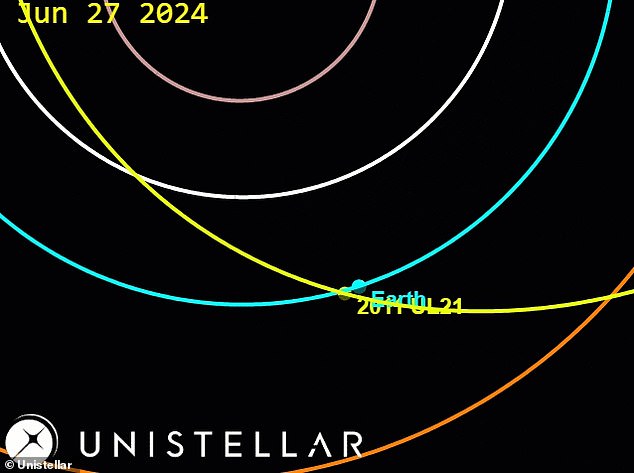How to watch the ‘planet killer’ asteroid crash past Earth – the largest space rock to come this close in 125 years
A giant ‘planet killer’ asteroid will crash past Earth on Thursday, the largest to come this close in 125 years.
The Mount Everest-sized space rock, 2011 UL21, has an estimated diameter of more than 7,500 feet (2,300 meters) and could cause significant climate changes if it were to impact our planet.
The ‘potentially dangerous’ asteroid will travel at a speed of 90,000 kilometers per hour within a radius of six million kilometers around Earth.
The flyby is scheduled for approximately 4:00 PM ET, but northern hemisphere skygazers will have the best views of June 28 and 29, when UL21 2011 will be at its brightest.
A giant ‘planet killer’ asteroid will crash past Earth on Thursday, the largest to come so close in 125 years
“This asteroid is larger than 99 percent of all known objects near Earth,” the European Space Agency shared in an announcement.
‘However, it won’t come nearly as close to Earth.
“At its closest point on June 27, it will be more than seventeen times as far away as the moon.”
But the asteroid will return to Earth in 2089, when it will come within 1.7 million miles of our planet.
2011 UL21 was documented on October 17, 2011 by the Catalina Sky Survey project, a series of telescopes in Arizona.
“2011 UL21 is quite large and falls into the category of Apollo asteroids,” the SETI Institute said.
‘Named after the Greek god Apollo, who was known for his epic journeys, these asteroids come in a range of sizes, from a few meters to several kilometers in diameter, such as 2011 UL21.
“More importantly, Apollo asteroids come very close because they cross Earth’s orbit, even though their orbits around the Sun are larger than Earth’s.”

2011 UL21 is expected to come within six million kilometers of Earth on June 27, its closest approach in 110 years – the asteroid orbits the Sun approximately every 1130 days
Astronomers have been closely watching 2011 UL21 for months, monitoring its trajectory to make sure people on Earth are safe.
“The term ‘Potentially Hazardous Asteroid’ (PHA) is a precise formal definition, referring to small planets larger than about 140 metres and that can come within a radius of 7.5 million kilometres from Earth,” said Gianluca Masi, astrophysicist and scientific director of the Virtual Telescope Project that organizes a livestream for the event.
“In other words, only the largest asteroids that can get close enough to our planet are marked as PHAs, which doesn’t mean they will hit Earth, but they nevertheless warrant closer monitoring.”
2011 UL21 is also categorized as a ‘planet killer’, which is defined as an asteroid that could cause damage on a continental scale and would produce enough debris upon impact that would cause significant climate changes. LiveScience reports.
Scientists at the Massachusetts Institute of Technology announced in 2023 that an asteroid in that category would not hit Earth for at least 1,000 years.
